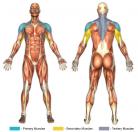Arnold Presses (Dumbbell)
- Sit or stand being sure to keep the back straight and grasp the dumbbells.
- If the weight is heavy, you may have to knee the weights into position.
- With the palms facing inward move the weights to the chest. When in the start position, the elbows will be pointing forward.
- Press the weight vertically while rotating the weights 180 degrees at the wrists, exhaling throughout the movement.
- The palms should now be facing outward and the weights should be fully suspended in line with the shoulders.
- Slowly lower the weight to the start position (elbows in front of chest), inhaling throughout the movement.
- Repeat steps 4-6.
Using a back rest will help to prevent injury by providing lower back support and reducing improper arching of the back.
Each of the following is a head of the deltoid collective and its corresponding term:
Anterior Deltoid = Front Shoulder
Posterior Deltoid = Rear Shoulder
Lateral Deltoid = Side Shoulder (Middle Shoulder)
A false grip - that is, a grip where the thumbs are not wrapped around the bar - can provide additional power and enable more weight to be lifted. However, a potential consequence of using this grip could be injury. If the hands are sweaty or form falters the weight may fall at the peril of you or others. Many claim that it is more comfortable to hold the bar in this manner, but for most a false grip begs for wrist hyperextension and falling weight injuries. Unless you are a professional, a false grip should prove unnecessary.





